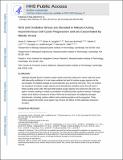ROS and Oxidative Stress Are Elevated in Mitosis during Asynchronous Cell Cycle Progression and Are Exacerbated by Mitotic Arrest
Author(s)
Patterson, Jesse C; Joughin, Brian Alan; Van De Kooij, Lambertus W.; Lim, Daniel Cham-Chin; Yaffe, Michael B; Lauffenburger, Douglas A; ... Show more Show less
DownloadAccepted version (673.7Kb)
Publisher with Creative Commons License
Publisher with Creative Commons License
Creative Commons Attribution
Terms of use
Metadata
Show full item recordAbstract
Although elevated levels of reactive oxygen species (ROS) have been observed in cancer cells and cancer cells aberrantly proliferate, it is not known whether the level of reactive oxygen species and the accumulation of oxidative damage to macromolecules vary across the cell cycle. Here, we measure the prevalence of reactive oxygen species and of biomolecule oxidation across the cell cycle in freely cycling cancer cells. We report that reactive oxygen species vary during the cell cycle and peak in mitosis, resulting in mitotic accumulation of oxidized protein cysteine residues. Prolonged mitotic arrest further increased the levels of ROS and the abundance of oxidatively damaged biomolecules, including cysteine-sulfenic-acid-containing proteins and 8-oxoguanine. These finding suggest that mitotic arrest agents may enhance the effects of ROS-dependent anticancer therapies. We studied connections between ROS and the cell cycle in unsynchronized cancer cells and using multiple independent assays found that ROS and oxidative damage to biomolecules are highest in mitosis and can be further enhanced by mitotic arrest.
Date issued
2019-02Department
Massachusetts Institute of Technology. Department of Biology; Massachusetts Institute of Technology. Department of Biological Engineering; Koch Institute for Integrative Cancer Research at MITJournal
Cell systems
Publisher
Elsevier BV
Citation
Patterson, Jesse C. et al. “ROS and Oxidative Stress Are Elevated in Mitosis during Asynchronous Cell Cycle Progression and Are Exacerbated by Mitotic Arrest.” Cell systems (2019): 163-167.e2 © 2019 The Author(s)
Version: Author's final manuscript
ISSN
2405-4720
2405-4712